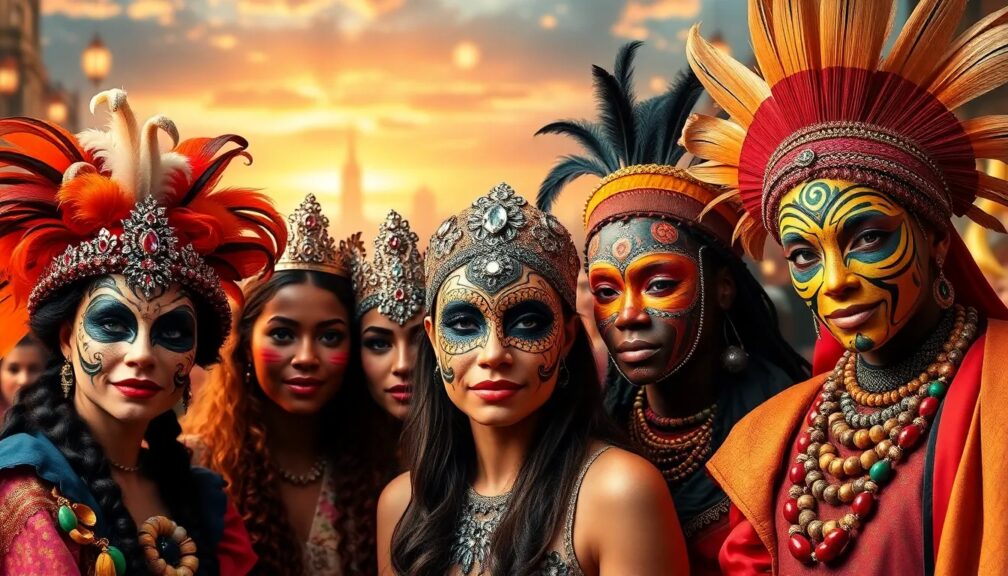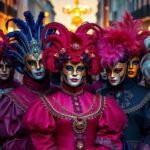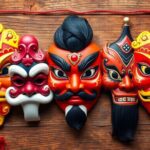The Fascinating World of Masks: History, Culture, and Significance

Did you know that masks have been a part of human culture for over 9,000 years? The earliest known masks, discovered in Israel, date back to around 7000 BCE and were made from plaster and painted with intricate designs. These artifacts are not just remnants of ancient craftsmanship; they offer a glimpse into the human psyche and cultural practices of our ancestors. Masks have served various purposes throughout history, from protection against evil spirits to instruments of performance and art, revealing the multifaceted roles they play in societies around the world.
As we delve into the world of masks, we will explore their rich history, the diverse types of masks used across different cultures, and the meanings and rituals associated with them. We will uncover famous masks from history, their cultural significance, and the ways in which they continue to inspire modern artistry and expression. Whether used in traditional ceremonies, theatrical performances, or contemporary art, masks remain a powerful symbol of identity and transformation.
The Origins of Masks
The journey of masks begins in the ancient world, where they were first utilized for spiritual and ceremonial purposes. Early masks were often crafted from natural materials such as wood, bone, and animal hides. These masks were not merely decorative; they served as conduits between the physical and spiritual worlds. For many indigenous cultures, masks were believed to embody the spirits of ancestors or deities, allowing wearers to channel their energies during rituals.
The significance of masks can be seen in ancient Egyptian culture, where they played a crucial role in burial practices. The famous golden funerary mask of Tutankhamun is a prime example of how masks were used to protect the deceased and ensure a safe passage to the afterlife. This stunning artifact, adorned with precious materials and intricate details, reflects the reverence ancient Egyptians had for their dead and their beliefs surrounding immortality.
In addition to their spiritual functions, masks also emerged as tools for storytelling and entertainment. Ancient Greeks used masks in theater to portray different characters and emotions, shaping the early foundations of Western drama. The exaggerated features of Greek theater masks allowed audiences to easily identify the roles being performed, making them an essential element of theatrical tradition. This early use of masks laid the groundwork for the various forms of performance and expression we see in cultures around the world today.
Types of Masks in Different Cultures
Masks come in an astonishing variety of forms, each variant reflecting the unique cultural context from which it originates. African masks, for instance, are renowned for their intricate carvings and symbolic meanings. They are often used in ceremonial dances, representing ancestors or spirits that guide the living. One iconic example is the Baule mask from the Ivory Coast, characterized by its elegant form and vibrant colors, which embodies the spirit of a revered ancestor during the performance of ritual dances.
In Asia, masks hold a place of honor in many traditional practices. The Japanese Noh masks are particularly noteworthy, as they are crafted to convey specific emotions and character traits. Each Noh mask is meticulously designed to suggest a range of expressions, from joy to sadness, allowing actors to embody the essence of their roles. This art form demonstrates the deep connection between masks and the storytelling traditions that span thousands of years.
Meanwhile, the masks of the Indigenous peoples of the Americas serve not only as artistic expressions but also as powerful spiritual symbols. The Kwakwaka'wakw of British Columbia are known for their elaborately carved masks, which are used in potlatch ceremonies to convey stories and honor ancestral spirits. These masks often depict animals or supernatural beings and are integral to the community's identity, highlighting the importance of storytelling in preserving cultural heritage.
The Symbolic Meanings of Masks
Masks are imbued with rich symbolism, often representing the duality of existence—life and death, reality and illusion. In many cultures, wearing a mask allows individuals to transcend their everyday identities and step into another realm. This transformation can serve various purposes, from healing to celebration, and speaks to the universal human desire to explore different aspects of existence.
For example, in Venetian Carnival, masks are synonymous with anonymity and liberation. Participants don elaborate masks and costumes, allowing them to break societal norms and embrace a sense of freedom. This tradition reflects a desire to escape the confines of daily life and explore the hidden facets of one’s identity. The famous Bauta mask, with its distinctive shape and lack of facial features, exemplifies this concept, as it allows wearers to blend into the crowd while engaging in revelry.
In contrast, the masks used in African tribal rituals often serve as a means of connecting with the spiritual world. These masks are not simply worn; they are believed to come alive during ceremonies, channeling the spirits they represent. The meaning behind each mask is profound, often representing specific ancestors, deities, or forces of nature. This connection between the physical and spiritual realms reinforces the importance of communal identity and continuity within these cultures.
Furthermore, masks have been used in various forms of protest and social commentary. The Guy Fawkes mask, popularized by the film "V for Vendetta," has become a symbol of resistance against tyranny and oppression. Initially associated with the British plot to blow up the Houses of Parliament in 1605, it has been repurposed by modern activists to represent the fight for freedom and justice. This transformation of a historical symbol into a contemporary emblem of protest illustrates the dynamic nature of masks and their ability to adapt to changing cultural contexts.
Famous Masks Throughout History
Throughout history, certain masks have gained notoriety for their artistic significance or cultural impact. One of the most famous masks is the Mask of Agamemnon, discovered in the ancient Greek site of Mycenae. This gold funeral mask, believed to date back to the 16th century BCE, is associated with the legendary figure Agamemnon from Homer's "Iliad." Its stunning craftsmanship and historical importance have made it a celebrated artifact, representing the wealth and artistry of Mycenaean civilization.
Another iconic mask is the Mona Lisa mask, which gained fame as a modern take on the classic painting by Leonardo da Vinci. This mask not only serves as a playful nod to the original artwork but also comments on the nature of identity and perception in contemporary society. It has become a popular item in mask culture, often worn at parties and events to spark conversation about art and interpretation.
The Hannibal Lecter mask, famously portrayed in the film "The Silence of the Lambs," has also become a cultural phenomenon. Designed to restrain the character's violent tendencies, this mask symbolizes the intersection of horror and psychology. It has transcended its fictional origins, becoming a widely recognized image associated with fear, control, and the darker aspects of human nature.
The Role of Masks in Performance Art
Masks have played a pivotal role in the development of performance art across cultures. From ancient rituals to contemporary theater, masks allow performers to explore complex themes and emotions while engaging audiences in transformative experiences. The use of masks in performance can transport viewers to different worlds, challenging perceptions and evoking powerful responses.
In traditional Japanese Kabuki theater, for instance, masks, or onnagata, are used to portray female characters by male performers. These masks enable actors to convey femininity and express a wide range of emotions, despite being physically male. The art of Kabuki is deeply rooted in cultural aesthetics and storytelling, and masks serve as a vital tool in creating a rich theatrical experience that captivates audiences.
Similarly, the Commedia dell'Arte of Renaissance Italy relied heavily on the use of masks to define character archetypes. Each mask represented a specific persona, from the clever servant to the foolish old man, allowing performers to exaggerate traits and create comedic scenarios. This form of theater emphasized improvisation and audience interaction, showcasing the versatility and impact of masks on the performance experience.
In contemporary art, masks continue to inspire innovation and exploration. Artists like Kehinde Wiley have incorporated masks into their work to challenge traditional notions of identity and representation. By blending historical references with modern aesthetics, these artists use masks as a medium to provoke thought and spark conversations about culture, race, and individuality. The evolution of masks in performance art demonstrates their enduring relevance and adaptability in expressing the human experience.
Masks in Modern Society
In today’s world, masks have taken on new meanings and forms, particularly in the wake of global events that have altered our daily lives. The advent of the COVID-19 pandemic brought about a resurgence in the use of face masks, transforming them from mere protective gear into symbols of solidarity, health, and community responsibility. As individuals donned masks to protect themselves and others, the act became a collective statement about the importance of caring for one another in challenging times.
Additionally, the rise of social media and digital culture has led to a renewed interest in masks as a form of self-expression. Many creators and influencers use masks in their visual content, employing them as tools to explore identity, anonymity, and creativity. The use of masks in photography and videography allows individuals to present curated versions of themselves or to comment on societal norms surrounding beauty and appearance.
Moreover, the resurgence of interest in traditional mask-making practices has sparked a revival of cultural heritage and craftsmanship. Artisans around the world are embracing the art of mask-making, passing down techniques and stories to new generations. This movement not only honors the rich histories associated with masks but also fosters a sense of pride and connection to cultural roots.
In summary, masks have transcended their original functions, evolving into powerful symbols that resonate across cultures and time periods. From ancient rituals to contemporary art forms, masks invite us to explore the complexities of identity, community, and expression, reminding us of our shared humanity and the stories we carry within us.



